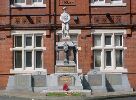
Newton-le-Willows and
Earlestown War Memorial

| OTHER WARS |
 |
Newton-le-Willows andEarlestown War Memorial |
 |
| The
Great War Roll of Honour |
|||||||||||||||||||||||||

Samuel Johnston was the son of John and Mary Ann Johnston. While the Memorial and the newspaper obituary have "Johnstone", both the CWGC and SDGW have his name as ‘Johnston’ without the final ‘e’. The discrepancy was cleared up when Samuel's "burnt records" were published on the internet. These have "Johnston" throughout.
According to the obituary in the Newton and Earlestown Guardian of November 3rd 1916, his father died during a nineteenth century battle. Samuel originally worked at the Bottle Works, but enlisted in 1893 when he was 21 (NEG gives his age at death as ‘about 44’). He served for eighteen years, nearly thirteen of them in India.
After leaving the army, he worked as a labourer at the Vulcan Foundry before rejoining on October 15th 1915, going out to France three or four months before his death, according to NEG. In fact his "burnt records" state that he disembarked at Rouen on 31st August, joining the 2nd Battalion on the 8th September, less than a month before his death. Nevertheless during this time he was "severely reprimanded by C.O. for insolence to his superior officer."
Samuel was a single man who lived with Mr Cawley at 18 Wargrave Road. The newspaper obituary includes a letter from Lance-Corporal Williams to Samuel’s brother, Mr J. Johnstone of 160, Bolton Road, Ashton-in-Makerfield. This letter describes how Samuel was killed: “A shell came over when he was cleaning his rifle in the trench and caught him in the head. He never murmured; it was all over in a minute.”
Although he was killed in an allied trench so one would expect him to have been buried in a marked grave, Samuel’s name is on the Thiepval Memorial to the Missing of the Somme. This could be explained as the Regimental Diary records the conditions on the day of Samuel’s death:
“Owing to heavy rain the ground and forward trenches, which were reduced
to chaos by continuous shelling and intense bombardment, the relief was not
completed until about 10 a.m.
Ration parties which left MOUQUET FARM at 5 p.m. yesterday did not arrive
in new trenches till this morning, and then in a very exhausted condition
– many of the men being out for over 24 hours.
The trenches generally were in a very bad state – filthy and full of
dead – both British and German. Enemy’s artillery and snipers
very active.
Orders had been issued for Battalion to attack and capture REGINA TRENCH opposite
‘B’ & ‘C’ Companies, but this was cancelled.
During the day trenches dried up a little and although there were frequent
bursts of shelling men were able to obtain a little rest. Battalion disposed
as shown below. Fairly quiet night.
Casualties during the day:- Other ranks 4 killed – 13 wounded. 2/Lieut.
THOMPSTONE to Field Ambulance.”
Private George Jackson, also of the 2nd Battalion and who had an even shorter period in France, was killed two days before Samuel.